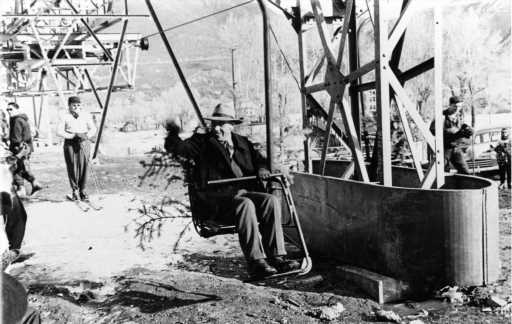Aspen, A-Basin mark 75 years in operation while Breckenridge turns 60
Two ski areas pioneered by 10th Mountain Division combat veterans in the aftermath of World War II, and another co-founded by a Norwegian who lived under Nazi occupation in his homeland during the war, are observing landmark anniversaries this ski season in Colorado.
Aspen Mountain and Arapahoe Basin are celebrating 75 years, while Breckenridge is marking 60. Loveland, Winter Park and Monarch are the only sizable Colorado areas that are older than Aspen and A-Basin. Howelsen Hill, a small skiing complex in Steamboat Springs that has launched dozens of Olympians, began operations in 1915 and is Colorado’s oldest continuously operated ski area.
The impetus for developing Aspen Mountain for skiing came from Friedl Pfeifer, a former Austrian racer and ski instructor who discovered the potential of the former mining town while training for mountain warfare with the 10th Mountain Division ski troops when they were stationed at Camp Hale near Leadville.
“I knew the day I saw it, and I let it be known,” Pfeifer said in a 1986 interview, eight years before his death. “I went before the city council and told them that I wanted to come back after the war and turn it into a ski resort. It was just a natural. God put it there, and he had skiers in mind.”
Pfeifer, who lost a lung while fighting Nazi occupiers in Italy, made the ski area a reality with the financial backing of Chicago industrialist Walter Paepcke. Paepcke’s wife, Elizabeth, first visited Aspen in 1939 and found it to be “a beautiful little Victorian village that had gone to sleep,” as she put it in a 1986 interview. She brought her husband there after the war and he was smitten, too.
While Pfeifer got the ski operation up and running, Paepcke gathered investors for the ski company and got to work bringing back the town’s former Victorian charm, which had grown weather-beaten and delapidated since the collapse of the silver boom in 1893.
Numerous 10th Mountain Division veterans joined Pfeifer, helping cut the initial ski trails on a mountain riddled with abandoned mineshafts. In 1950, Aspen successfully hosted the world alpine ski championships, shocking European racers with the quality of skiing and putting the fledgling resort on the international map.
“I think they were curious,” said the late Dick Durrance, a 1936 Olympic ski racer who was Aspen’s general manager from 1947 to 1952. “But when everybody came over here, their eyes opened up. All of a sudden they began to realize maybe there was some skiing in North America.”
Before coming to Aspen, Durrance helped start Arapahoe Basin with 10th Mountain veteran Larry Jump and another former ski racer, Sandy Schauffler. A-Basin opened in December 1946 with a single rope tow from mid-mountain to the summit.
Arapahoe Basin is located at the foot of Loveland Pass on the Summit County side. During its first two decades of operation, the Eisenhower-Johnson tunnels didn’t exist, meaning the quickest way to Summit County was over the pass. Arapahoe Basin grew, but when the first two-lane tunnel bore under the Continental Divide opened in 1973, eliminating the need for westbound skiers to brave the two-lane road over the 11,991-foot pass, Jump saw it as a threat and sold the area.
“Dad sold it at that point in time because he thought nobody was going to come over the pass from Denver,” Jump’s son, Mike, recalled this week. “I kept trying to tell him, ‘Dad, they love this place, they’ll come whichever way they can.’ They’re doing it now. If the pass is closed, they go down to Dillon (via the tunnel) and come back up the hill.”
Larry Jump died in 1989. On the occasion of the area’s 50th anniversary in 1996, Jump’s widow, Marnie, spoke for him.
“He’d be elated, absolutely elated,” said Marnie, who died in 2011. “He’d be so proud of the way things are.”
A-Basin was Summit County’s only ski area until December of 1961, when Breckenridge opened under the name Peak 8. Construction had begun that year on a dam that would create Lake Dillon, meaning Summit County was about to become a recreation destination.
Breckenridge co-founder Trygve Berge, a Norwegian who can tell hair-raising stories about the Nazi occupation he witnessed as a boy, competed in the 1956 Olympics and became a protege of ski legend Stein Ericksen. In 1958, Ericksen brought him to the U.S. to work in the ski school at Aspen Highlands.
Berge got a summer job at a Breckenridge lumber yard, where he met Ralph Rounds, a son of the man who owned the lumber company. In the summer of 1960, Berge and fellow Norwegian Sigurd Rockne led Rounds on a hike up Peak 8 to show him its potential for skiing. He agreed with them, and they toasted their decision to develop it as a ski area with a bottle of Cutty Sark cut with fresh mountain spring water. Berge and Rockne laid out the first trails on Peak 8 in the summer of 1961, and the ski area opened that December.
Like Aspen, Breckenridge was a small former mining town at the time. Berge bought four lots near the center of town on Main Street from Rounds in 1960.
“Rounds gave me a good deal,” Berge said this month in an interview, mirth in his voice. “Guess how much: Five hundred bucks.”
Berge ran the ski school for 10 years, but after the Aspen Skiing Company bought the ski area, Berge quit and went to work as a stonemason. He will turn 90 in April but still skis often.
Breckenridge now sprawls across the eastern face of the Tenmile Range, having expanded to include Peak 9, Peak 10, Peak 7 and Peak 6. A beginner run at the bottom of Peak 8 is named Trygve’s in Berge’s honor.
The Aspen Skiing Company long ago grew to include three other mountains in the Roaring Fork Valley (Aspen Highlands, Snowmass and Buttermilk).
Aspen, A-Basin and Breckenridge all have had multiple owners since they were founded. Breckenridge is currently owned by Vail Resorts and Aspen is owned by the Crown family of Chicago. A-Basin is owned by Dream Industrial, a Canadian real estate investment trust.
Subscribe to our weekly newsletter, The Adventurist, to get outdoors news sent straight to your inbox.
Source: Read Full Article





